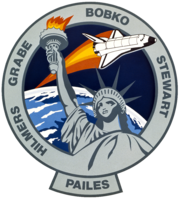STS-51-J

Liftoff of the first flight of Atlantis and the STS 51-J mission.
|
|
| Mission type | Satellite deployment |
|---|---|
| Operator | NASA |
| COSPAR ID | 1985-092A |
| SATCAT no. | 16115 |
| Mission duration | 4 days, 1 hour, 44 minutes, 38 seconds |
| Distance travelled | 2,707,948 kilometres (1,682,641 mi) |
| Orbits completed | 64 |
| Spacecraft properties | |
| Spacecraft | Space Shuttle Atlantis |
| Landing mass | 86,400 kilograms (190,400 lb) |
| Payload mass | 19,968 kilograms (44,022 lb) |
| Crew | |
| Crew size | 5 |
| Members |
Karol J. Bobko Ronald J. Grabe David C. Hilmers Robert L. Stewart William A. Pailes |
| Start of mission | |
| Launch date | 3 October 1985, 15:15:30 UTC |
| Launch site | Kennedy LC-39A |
| End of mission | |
| Landing date | 7 October 1985, 17:00:08 UTC |
| Landing site | Edwards Runway 23 |
| Orbital parameters | |
| Reference system | Geocentric |
| Regime | Low Earth |
| Perigee | 475 kilometres (295 mi) |
| Apogee | 484 kilometres (301 mi) |
| Inclination | 28.5 degrees |
| Period | 94.2 min |
 L-R: Stewart, Hilmers, Bobko, Pailes, Grabe |
|
STS-51-J was the 21st NASA Space Shuttle mission and the first flight of Space Shuttle Atlantis. It launched from Kennedy Space Center, Florida, on 3 October 1985, carrying a payload for the U.S. Department of Defense, and landed at Edwards Air Force Base, California, on 7 October.
Before William Pailes was assigned to the STS-51-J flight, Richard M. Mullane was rumored to have been assigned as Mission Specialist 3 on his second trip to space.
STS-51-J launched on 3 October 1985, at 11:15 EDT, from Launch Pad 39A at the Kennedy Space Center. The launch was delayed by 22 minutes and 30 seconds due to a problem with a main engine liquid hydrogen prevalve close remote power controller; the controller was showing a faulty "on" indication.
The mission was the second shuttle flight totally dedicated to deploying a Department of Defense payload, after STS-51-C. Its cargo was classified, but it was reported that two (USA-11 and USA-12) DSCS-III (Defense Satellite Communications System) satellites were launched into stationary orbits by an Inertial Upper Stage. The DSCS satellites used X-band frequencies (8/7 GHz). Each DSCS-III satellite had a design life of ten years, although several of the DSCS satellites have far exceeded their design life expectancy.
...
Wikipedia

